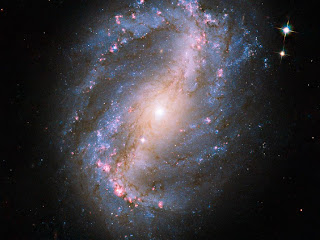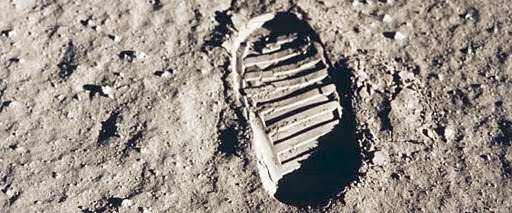We know more about the moon than, ..... wait,... this just in, .... what??
It turns out that we don't know as much about the moon as we thought. Data provided by three different space probes confirms the spectral signature of water. But the water isn't localized to just the poles as scientists expected. It was found throughout the surface apparently locked up among minerals in the lunar soil.
What this means is that potential habitation on the moon just got a "giant step" easier. We have oxygen and hydrogen resources available at many points among the surface, not just at the extreme poles. Hydrogen would be available for fuel and oxygen for breathing. Certainly more research has to be performed, but this is exciting news to many associated with space exploration.
Perhaps the moon, with it's significantly lower gravity, can now be slated as a springboard for future travel to other planets and moons. Of course that is in the distant future and even human travel to the moon for now is still far away. But it gives us a significant reason to go back.
Thursday, September 24, 2009
Monday, September 21, 2009
Beware the Equinox
Wow. And here I thought the Equinox was a celestial phenomenon whereby the day and night were split into equal halves. You know pretty much 12 hours of day and 12 of night. And the equinox starting on Septemeber 22nd allows us on the northern hemisphere to see the daylight whittling away minute by minute each night until we are at the winter solstice.
As I came by this video I was shocked and disturbed before I burst out in maniacal, Dr Evil type, laughter. Go ahead take a peek, but be warned. The Equinox is not what we think it is. Hahahahahahahahahahahahah, ... haha. .ha......h a. .
As I came by this video I was shocked and disturbed before I burst out in maniacal, Dr Evil type, laughter. Go ahead take a peek, but be warned. The Equinox is not what we think it is. Hahahahahahahahahahahahah, ... haha. .ha......h a. .
Friday, September 18, 2009
Ares I NASA Test Video
This is the Ares I rocket motor test. It is one powerful rocket motor and is at the core of the Constellation program designed to get us back to the moon. Unfortunately, missions to the moon aren't cheap and NASA is facing some major changes without adequate funding. Have to keep an eye on that.
I found this video hiding out at Phil Plait's Bad Astronomy site.
I found this video hiding out at Phil Plait's Bad Astronomy site.
Thursday, September 17, 2009
Move over Kepler, Rocky Earth-like Exoplanet Discovered
News just in indicates the discovery of the first rocky planet outside of our own solar system. It is unlikely enough to harbor life. So much so that we may as well say, "It has no life". The temperature range is something like 3200 degrees F to minus 320 degrees. It is very close to its home star with a locked rotation (like our moon)and a year on this planet would be less than a day on Earth.
Let me define "it". Scientists have named this planet CoRoT-7b. Not so colorful but nomenclature is everything. It's about 5 times the mass of Earth and about twice the diameter. And it is approximately 500 light years away. Earthlike may be a misleading term, but it is significantly different than al the hot Jupiter type exoplanets that have been discovered thus far. As one scientist noted it may be more like Dante's Inferno. Still a notable discovery.
And while I mention "Move Over Kepler" I guess I just expected Kepler to be the mission that discovered such a planet. But this bodes really well for that mission because now we know of at least one planet that is solid enough to tread on. Kepler is looking for similar rocky Earthlike planets as well. But the difference being that Kepler is looking for planets in the habitable zones around stars. The habitable zone is an area where water would be present in liquid form. Kepler will keep it's "eyes" on a large group of stars for the next three years in order to do so. In the meantime, this discovery is very exciting and encouraging. Thats is, if you care about worlds that might be inhabited outside of our own humble planet.
http://www.cnn.com/2009/TECH/space/09/16/new.rocky.planet/
Let me define "it". Scientists have named this planet CoRoT-7b. Not so colorful but nomenclature is everything. It's about 5 times the mass of Earth and about twice the diameter. And it is approximately 500 light years away. Earthlike may be a misleading term, but it is significantly different than al the hot Jupiter type exoplanets that have been discovered thus far. As one scientist noted it may be more like Dante's Inferno. Still a notable discovery.
And while I mention "Move Over Kepler" I guess I just expected Kepler to be the mission that discovered such a planet. But this bodes really well for that mission because now we know of at least one planet that is solid enough to tread on. Kepler is looking for similar rocky Earthlike planets as well. But the difference being that Kepler is looking for planets in the habitable zones around stars. The habitable zone is an area where water would be present in liquid form. Kepler will keep it's "eyes" on a large group of stars for the next three years in order to do so. In the meantime, this discovery is very exciting and encouraging. Thats is, if you care about worlds that might be inhabited outside of our own humble planet.
http://www.cnn.com/2009/TECH/space/09/16/new.rocky.planet/
Wednesday, September 16, 2009
Near Space Photos on a Budget

A few students from MIT created a plan to shoot some photo's from pretty high up in the sky. About 17 miles high that is. They launched a helium ballon with the camera and a prepaid cell phone to serve as a GPS tracking unit. The rest was basically duct tape. Kidding aside, here is a list of the equipment and prices paid for them. The whole project cost less than $150!!
In addition to this interesting and frugal accomplishment, the students will also soon release a step by step how-to guide on launching your own low budget, near space, camera. Might I sense a science fair project in the future?? Oh yes, the guide will be low budget as well for anyone interested in taking on such a project. The guide will be free.
In addition to this interesting and frugal accomplishment, the students will also soon release a step by step how-to guide on launching your own low budget, near space, camera. Might I sense a science fair project in the future?? Oh yes, the guide will be low budget as well for anyone interested in taking on such a project. The guide will be free.
Photo courtesy of Oliver and Justin (http://space.1337arts.com/)
Thursday, September 10, 2009
New Deep Space Images ala Hubble

Do the images from the Hubble Telescope ever cease to amaze?? Check out some of the newest "Hubble Refurbished" images here.
Space Junk Averted Again
Space junk is becoming more and more of a problem these days. Littered areas of low Earth orbit put multi-million dollar satellites and even more important crafts like the Space Shuttle at risk. This time the astronauts had to fire the engines to miss the debris.
I'm not exactly sure what, if anything, is being done to address this problem. But as astronauts accidentily, if not clumsily, lose things like tools or if rockets continue to shed miscellaneous pieces into the sky, then this problem will continue grow. Where is the space magnet to vacuum (pun intended) up all this debris when you want it?
Space Shuttle Discovery Fires Engines to Dodge Debris
I'm not exactly sure what, if anything, is being done to address this problem. But as astronauts accidentily, if not clumsily, lose things like tools or if rockets continue to shed miscellaneous pieces into the sky, then this problem will continue grow. Where is the space magnet to vacuum (pun intended) up all this debris when you want it?
Space Shuttle Discovery Fires Engines to Dodge Debris
Subscribe to:
Posts (Atom)
